Refrigerator Cars (Trains): Inventor, Definition, History
Last revised: February 25, 2025
By: Adam Burns
Refrigerator cars, also commonly referred to by their shortened name as "reefers" were a revolutionary design that allowed for the widespread shipment of perishable food products such as dairy, meat, and vegetables.
The earliest such cars date back to the mid-19th century, naturally using ice as a means of cooling. After the development of the frozen food industry in the 1950s the reefer began to loose its near monopoly on the country's perishable business.
Likewise, by the 1970s railroads were dropping LCL (less-than-carload) and short-haul business allowing the trucking industry to pick up most perishable traffic, which continues to this day.
However, refrigerator cars and their precious contents are making a comeback as perishable centers are becoming more centrally located and distances to the products' final destinations are becoming further and further.
At one time reefers were a very common way to ship perishables, a business railroads once dominated. What changed?
As mentioned above, competition and the industry's disinterest in LCL largely decimated such traffic. If the industry showed as much interest as it did prior to the 1970's shippers would likely return. Unfortunately, their belief that such business has been forever "lost" makes this unlikely.
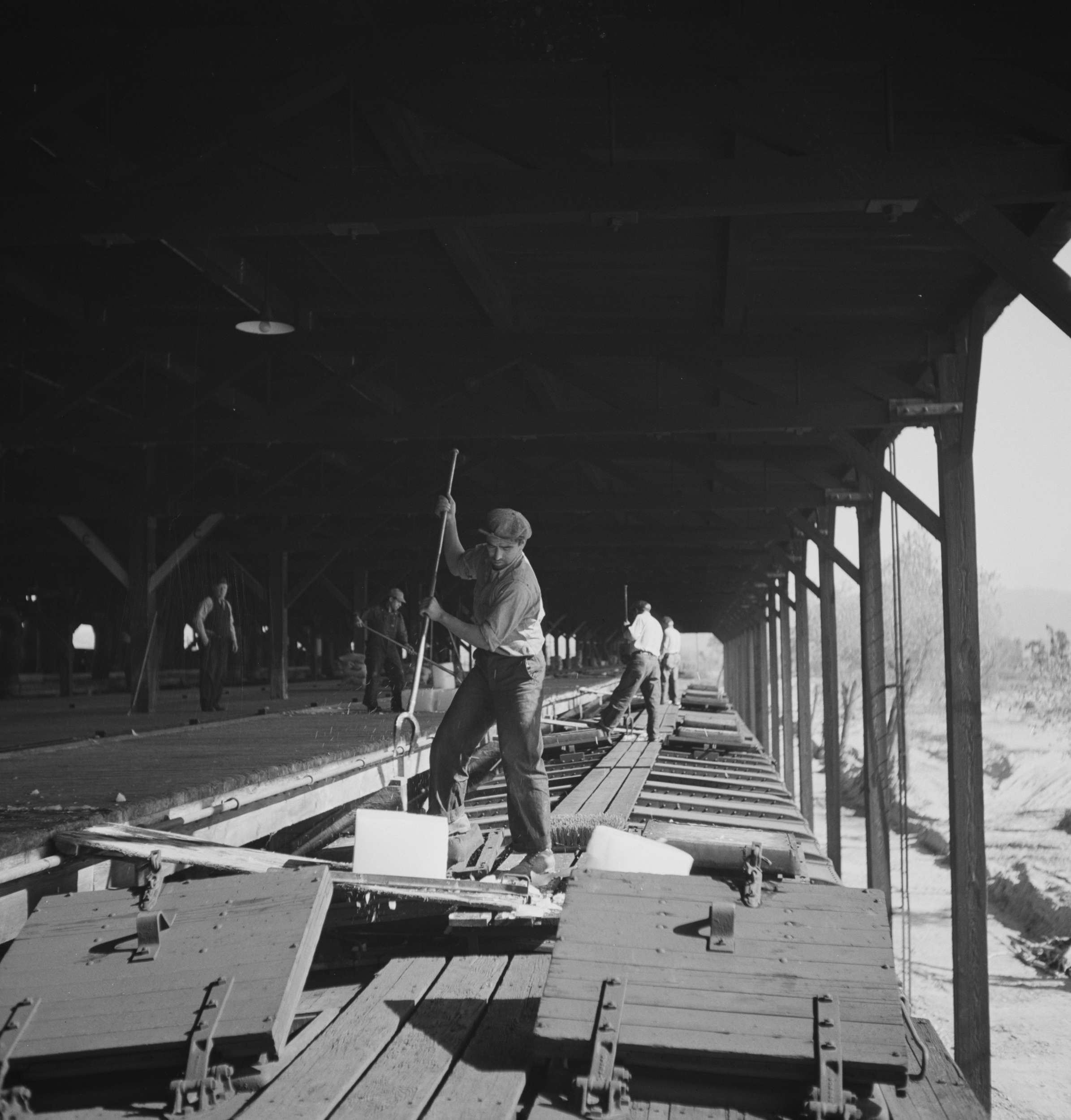 A worker packs ice into a Pacific Fruit Express Company (PFE) refrigerator at an ice plant in San Bernardino, California during March of 1943. The PFE was jointly owned by Union Pacific, Southern Pacific, and Western Pacific. It was the largest reefer company in the country. At its peak it owned 40,000 cars, 20 ice plants, and five maintenance shops.
Jack Delano photo.
A worker packs ice into a Pacific Fruit Express Company (PFE) refrigerator at an ice plant in San Bernardino, California during March of 1943. The PFE was jointly owned by Union Pacific, Southern Pacific, and Western Pacific. It was the largest reefer company in the country. At its peak it owned 40,000 cars, 20 ice plants, and five maintenance shops.
Jack Delano photo.A Brief History
Once the American public realized railroads were the fastest and most efficient means of transportation during the first-half of the 19th century it did not take long for businesses to realize that trains could move about anything imaginable.
This, of course, included food products. However, this poised a problem since food, naturally, is perishable and during the mid-19th century no type of refrigeration had been invented.
The First Designs
By 1851 the first refrigerator cars were being tested on the Northern Railroad (later part of the Rutland Railroad) in New York state. These cars featured some type of insulation and blocks of ice to keep the contents cool.
While quite successful much better insulation and cooling techniques needed to be developed before the reefer could be utilized year-round.
Experimental refrigerator cars became increasingly common throughout the 1850s with some simple solutions merely using blocks of ice in standard boxcars.
Around 1860 the first true refrigerator cars were born using heavy insulation, roof hatches, floor drains, and ice bunkers located at either end of the car.
These early cars usually employed some type of natural insulation such as mattes of cow hair, saw dust, or even plain old dirt! In 1867 J.B. Sutherland of Detroit, Michigan patented the first reefer, using a design very similar to that just mentioned.
In addition, Sutherland attempted to control the flow of air in the car to keep the food products well refrigerated.
However, despite these early advances in reefer technology, railroads were quite slow embracing the new car. Traditionally, railroads were, and still are to some extent, resistant to new technology on the basis of cost versus return.
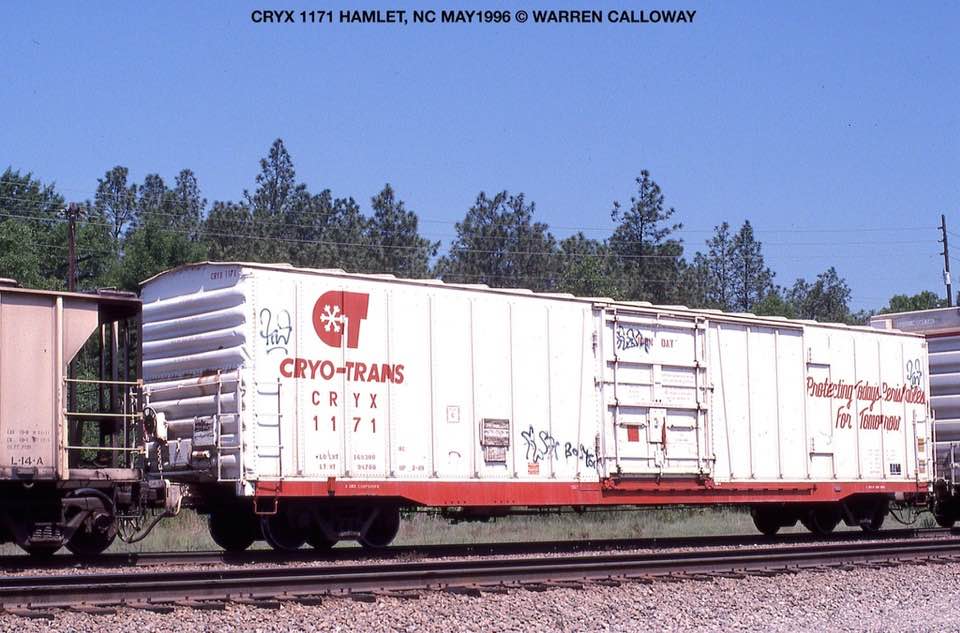 A modern, 57-foot Cryo-Trans Incorporated (CRYX) mechanical refrigerator car is seen here in service on CSX in Hamlet, North Carolina during May of 1996. These types of cars are well insulated and feature cushion draft gear in the underframe. Warren Calloway photo.
A modern, 57-foot Cryo-Trans Incorporated (CRYX) mechanical refrigerator car is seen here in service on CSX in Hamlet, North Carolina during May of 1996. These types of cars are well insulated and feature cushion draft gear in the underframe. Warren Calloway photo.This was the case with reefers whereby railroads felt that spending large sums of money for a fleet cars which would only carry one type of commodity was not worth the investment.
Additionally, railroads had already spent heavily on the development and movement of livestock along their lines. Realizing the need for refrigerator cars private shippers, particularly meatpackers, decided to build their own fleets.
By doing so, reefers were some of the first privately-owned cars to be used on railroads (known today as private-car lines).
As such, names like Armor in their classic yellow, and Swift began to appear on the sides of many refrigerator cars. It was not uncommon to see large cuts of these cars leaving Chicago and bound for the east coast all of the way through the 1950s.
By just the 1880s refrigerator cars had become quite advanced built with very heavy insulation and a standard size of about 36-feet in length since loading doors at packing plants were based on 36-foot centers.
Additionally, private shippers had developed large and sophisticated icing stations, which were usually located along major railroad division points.
While trains were being reclassified, engines maintained, and crews replaced the refrigerator cars would be transferred to these icing stations to restock their ice supplies.
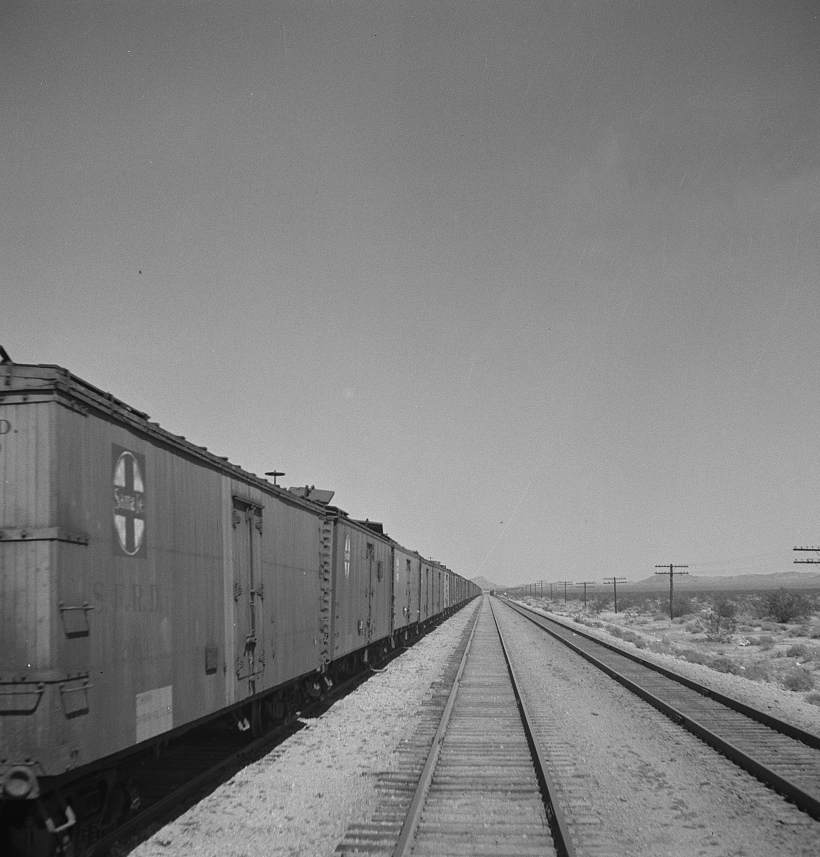 Classic wooden Santa Fe reefer cars are stored at Essex, California in March of 1943. Jack Delano photo.
Classic wooden Santa Fe reefer cars are stored at Essex, California in March of 1943. Jack Delano photo.In 1941 the first early type of air-conditioning came to the reefer when the Pacific Fruit Express Company developed an alternator-driven fan system (which was powered via the car's moving axle).
This system pushed air in large quantities through the ice bunkers and out of vents located near the ceiling, helping to better cool the car's contents.
Around this same time better insulating techniques were developed, such as rubber seals along the car's interior seams helped to keep even more outside air out, thus farther preserving the perishable contents.
However, it was the frozen-food industry of the 1950s that ultimately ended the reefer's dominance in moving perishable food.
Now, everything from vegetables and meats to the new "TV dinner" could be kept frozen and, generally, fresh for weeks at a time before they were eaten. The traditional ice-cooled refrigerator cars could not keep these perishable products completely frozen, which obviously created a big problem.
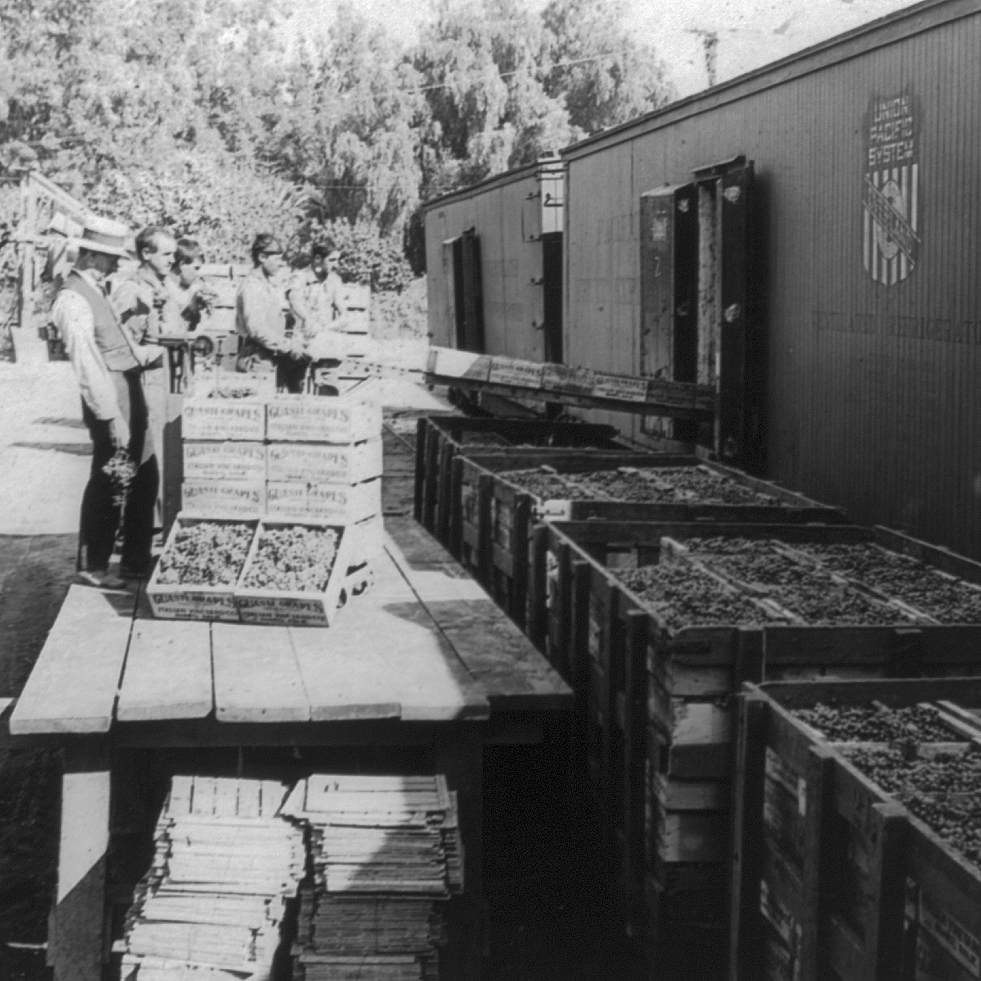 Grapes are loaded onto PFE cars at Guasti, California, bound for eastern markets, on June 4, 1923. Philip Brigandi photo.
Grapes are loaded onto PFE cars at Guasti, California, bound for eastern markets, on June 4, 1923. Philip Brigandi photo.Thus, the mechanical reefer was developed to alleviate this issue. The car was first successfully built and operated by the Fruit Growers Express Company just after World War II, which transported mostly southern citrus fruit from Florida to the Northeast.
The FGE's original car fleet used on board gasoline-powered engines to operate the refrigeration equipment.
However, with the development of the diesel-electric locomotive and its widespread use, Mike Schafer and Mike McBride note in their book, "Freight Train Cars," the company soon engineered their cars to utilize that technology after World War II.
Instead of a gas engine, a small diesel engine on each car powered an alternator, which produced electricity to run the refrigeration equipment.
The development of mechanized refrigerator cars allowed for them to become much larger and carry a greater yield of product. However, following World War II reefers slowly saw decreasing use throughout the industry.
The entire fleet had peaked in 1930 at 183,000 but by just 1950 had dropped to under 128,000.
Then, by the 1970s railroads began to severely reduce or outright eliminate less profitable LCL and short-haul traffic, further reducing the reefer fleet. To make matters worse, the 1970s also saw plummeting and unreliable freight service across the industry.
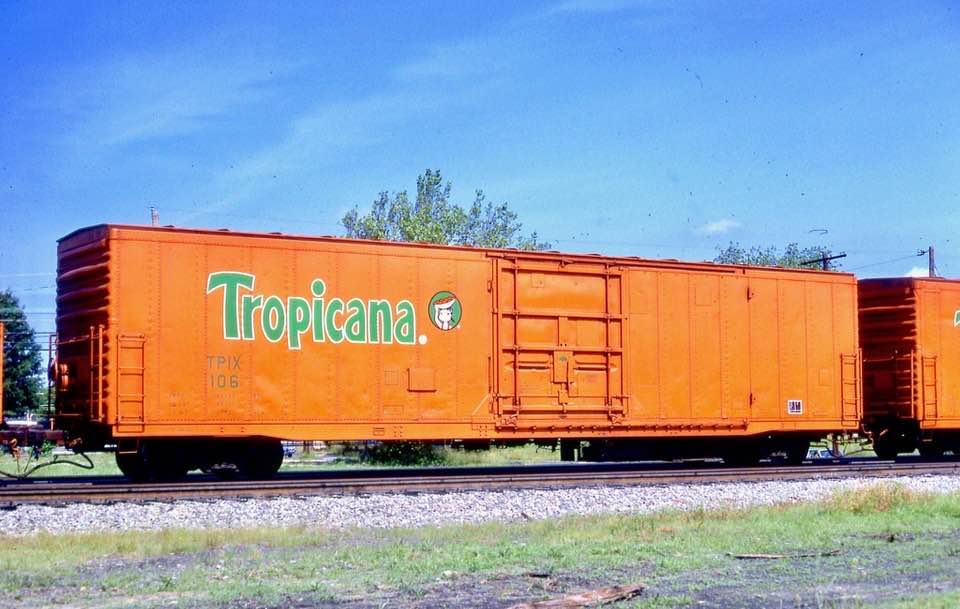 A modern 57-foot refrigerator car belong to Tropicana/Fruit Growers Express is seen here in service as part of the famous "Juice Train" (discontinued in 2017). Warren Calloway photo.
A modern 57-foot refrigerator car belong to Tropicana/Fruit Growers Express is seen here in service as part of the famous "Juice Train" (discontinued in 2017). Warren Calloway photo.Of particular note was the Southern Pacific, a system which had dominated the perishable market in California throughout most of the 20th century and prided itself on moving this freight fast and efficiently to eastern markets.
It had small branch lines and spurs snaking out to serve virtually every major farm in the San Joaquin Valley.
However, by the 1970s poor management saw service become so bad that entire trains of perishable traffic were rotten by the time they reached the east coast.
Unable to withstand such losses California growers switched to trucks, which were more expensive but also more reliable.
The SP lost virtually its entire perishable traffic business in just a few years and the skeletons of its dominance in the valley can still be seen by the many abandoned spurs and loading facilities.
Growers lost so much confidence in moving their product by train that in just the last five or 10 years have they begun to again try rail service, which in tests have actually proven to be quite successful.
By 2001 the refrigerator car fleet in the United States had dropped to an all-time low of around 8,000 cars.
However, today that number has rebounded to over 25,000 as farmers and growers have regained a level of trust in railroads to again move their precious product by rail.
Recent Articles
-
New Jersey ~ Murder Mystery ~ Dinner Train Rides
Jan 17, 26 01:16 PM
There are currently no murder mystery dinner trains available in New Jersey although until 2023 the Cape May Seashore Lines offered this event. Perhaps they will again soon! -
West Virginia Dinner Train Rides In Elkins!
Jan 17, 26 01:08 PM
The D&GV offers the kind of rail experience that feels purpose-built for railfans and casual travelers. -
Virginia Dinner Train Rides In Staunton!
Jan 17, 26 11:55 AM
If you’ve ever wished you could pair a classic scenic train ride with a genuinely satisfying meal—served at your table while the countryside rolls by—the Virginia Scenic Railway was built for you. -
Florida Easter Train Rides
Jan 17, 26 10:23 AM
The cold weather rarely invades Florida and the state nearly always warm and balmy early spring temperatures. Learn more about where you can find Easter-themed train rides across the Sunshine State. -
Ohio Easter Train Rides
Jan 17, 26 10:13 AM
Ohio is home to several museums and excursion trains preserving the state's rich railroading heritage. A few of these locations host Easter-themed train rides each spring. -
Massachusetts Valentine's Train Rides
Jan 17, 26 09:58 AM
The Cape Cod Central Railroad (CCCR) blends classic New England scenery with heritage equipment, narrated sightseeing, and some of the region’s best-known “rails-and-meals” experiences. -
California Valentine's Train Rides
Jan 17, 26 09:53 AM
Operating out of West Sacramento, this excursion railroad has built a calendar that blends scenery with experiences—wine pours, themed parties, dinner-and-entertainment outings, and seasonal specials… -
South Carolina Dinner Train Rides
Jan 16, 26 11:13 PM
There is only location in the Palmetto State offering a true dinner train experience can be found at the South Carolina Railroad Museum. Learn more here. -
Rhode Island Dinner Train Rides
Jan 16, 26 11:01 PM
Despite its small size, Rhode Island is home to one popular dinner train experience where guests can enjoy the breathtaking views of Aquidneck Island. -
Pennsylvania's Thomas The Train Rides
Jan 16, 26 04:13 PM
"A Day Out With Thomas” train rides offer a unique opportunity for children and their families to engage in a magical and memorable experience, setting the stage for a full day of fun and adventure. -
Illinois's Thomas The Train Rides
Jan 16, 26 02:23 PM
In Illinois, the "A Day Out With Thomas" event offers a unique chance for families to immerse themselves in the enchanting world of Thomas and friends, creating memories that last a lifetime. -
New Jersey's Thomas The Train Rides
Jan 16, 26 02:11 PM
Here's a comprehensive guide to what you can expect at Day Out With Thomas events in New Jersey. -
Texas ~ Murder Mystery ~ Dinner Train Rides
Jan 16, 26 01:54 PM
Here’s a comprehensive look into the world of murder mystery dinner trains in Texas. -
Connecticut ~ Murder Mystery ~ Dinner Train Rides
Jan 16, 26 01:26 PM
All aboard the intrigue express! One location in Connecticut typically offers a unique and thrilling experience for both locals and visitors alike, murder mystery trains. -
New Hampshire Dinner Train Rides In N. Conway!
Jan 16, 26 10:47 AM
Tucked into the heart of New Hampshire’s Mount Washington Valley, the Conway Scenic Railroad is one of New England’s most beloved heritage railways -
Oregon Dinner Train Rides Near Mt. Hood!
Jan 16, 26 10:44 AM
The Mt. Hood Railroad is the moving part of that postcard—a century-old short line that began as a working railroad. -
Maryland's - Wine Tasting - Train Rides
Jan 15, 26 02:59 PM
This article delves into the enchanting world of wine tasting train experiences in Maryland, providing a detailed exploration of their offerings, history, and allure. -
Colorado's - Wine Tasting - Train Rides
Jan 15, 26 02:46 PM
To truly savor these local flavors while soaking in the scenic beauty of Colorado, the concept of wine tasting trains has emerged, offering both locals and tourists a luxurious and immersive indulgenc… -
Iowa ~ Wine Tasting ~ Train Rides
Jan 15, 26 02:36 PM
The state not only boasts a burgeoning wine industry but also offers unique experiences such as wine by rail aboard the Boone & Scenic Valley Railroad. -
Georgia's Wine Train Rides In Cordele!
Jan 15, 26 02:26 PM
While the railroad offers a range of themed trips throughout the year, one of its most crowd-pleasing special events is the Wine & Cheese Train—a short, scenic round trip designed to feel like a t… -
Indiana ~ Murder Mystery ~ Dinner Train Rides
Jan 15, 26 02:22 PM
This piece explores the allure of murder mystery trains and why they are becoming a must-try experience for enthusiasts and casual travelers alike. -
Ohio ~ Murder Mystery ~ Dinner Train Rides
Jan 15, 26 02:10 PM
The murder mystery dinner train rides in Ohio provide an immersive experience that combines fine dining, an engaging narrative, and the beauty of Ohio's landscapes. -
Nevada Dinner Train Rides In Ely!
Jan 15, 26 02:01 PM
If you’ve ever wished you could step through a time portal into the hard-working world of a 1900s short line the Nevada Northern Railway in Ely is about as close as it gets. -
Michigan Dinner Train Rides In Owosso!
Jan 15, 26 09:46 AM
The Steam Railroading Institute is best known as the home of Pere Marquette #1225 and even occasionally hosts a dinner train! -
Arizona's - Wine Tasting - Train Rides
Jan 14, 26 02:04 PM
For those who want to experience the charm of Arizona's wine scene while embracing the romance of rail travel, wine tasting train rides offer a memorable journey through the state's picturesque landsc… -
Arkansas's - Wine Tasting - Train Rides
Jan 14, 26 01:57 PM
This article takes you through the experience of wine tasting train rides in Arkansas, highlighting their offerings, routes, and the delightful blend of history, scenery, and flavor that makes them so… -
Tennessee ~ Murder Mystery ~ Dinner Train Rides
Jan 14, 26 01:42 PM
Amidst the rolling hills and scenic landscapes of Tennessee, an exhilarating and interactive experience awaits those with a taste for mystery and intrigue. -
California ~ Murder Mystery ~ Dinner Train Rides
Jan 14, 26 01:26 PM
When it comes to experiencing the allure of crime-solving sprinkled with delicious dining, California's murder mystery dinner train rides have carved a niche for themselves among both locals and touri… -
Illinois ~ Murder Mystery ~ Dinner Train Rides
Jan 14, 26 01:13 PM
Among Illinois's scenic train rides, one of the most unique and captivating experiences is the murder mystery excursion. -
Vermont's - Murder Mystery - Dinner Train Rides
Jan 14, 26 12:57 PM
There are currently murder mystery dinner trains offered in Vermont but until recently the Champlain Valley Dinner Train offered such a trip! -
Massachusetts Dinner Train Rides On Cape Cod!
Jan 14, 26 12:20 PM
The Cape Cod Central Railroad (CCCR) has carved out a special niche by pairing classic New England scenery with old-school hospitality, including some of the best-known dining train experiences in the… -
Maine Dinner Train Rides In Portland!
Jan 14, 26 11:31 AM
While this isn’t generally a “dinner train” railroad in the traditional sense—no multi-course meal served en route—Maine Narrow Gauge does offer several popular ride experiences where food and drink a… -
Kentucky Dinner Train Rides In Bardstown!
Jan 13, 26 01:14 PM
The essence of My Old Kentucky Dinner Train is part restaurant, part scenic excursion, and part living piece of Kentucky rail history. -
Kansas Dinner Train Rides In Abilene!
Jan 13, 26 12:44 PM
If you’re looking for a heritage railroad that feels authentically Kansas—equal parts prairie scenery, small-town history, and hands-on railroading—the Abilene & Smoky Valley Railroad (A&SV) delivers. -
Michigan ~ Murder Mystery ~ Dinner Train Rides
Jan 13, 26 11:24 AM
Among the lesser-known treasures of this state are the intriguing murder mystery dinner train rides—a perfect blend of suspense, dining, and scenic exploration. -
Virginia's - Murder Mystery - Dinner Train Rides
Jan 13, 26 11:11 AM
Among the state's railroad attractions, murder mystery dinner trains stand out as a captivating fusion of theatrical entertainment, fine dining, and scenic travel. -
Arizona Dinner Train Rides At The Grand Canyon!
Jan 13, 26 10:59 AM
While the Grand Canyon Railway does not offer a true, onboard dinner train experience it does offer several upscale options and off-train dining. -
Georgia Dinner Train Rides In Nashville!
Jan 13, 26 10:27 AM
If you’ve ever wished you could slow down, trade traffic for jointed rail, and let a small-town landscape roll by your window while a hot meal is served at your table, the Azalea Sprinter delivers tha… -
Indiana Valentine's Train Rides
Jan 12, 26 04:27 PM
If you’ve ever wished you could step into a time when passenger trains were a Saturday-night treat and a whistle echoing across farm fields meant “adventure,” the Nickel Plate Express delivers that fe… -
Ohio Valentine's Train Rides!
Jan 12, 26 04:20 PM
The Hocking Valley Scenic Railway offers one of the region’s most atmospheric ways to experience the Hocking Hills area: from the rhythmic click of jointed rail to the glow of vintage coaches rolling… -
Wisconsin's - Wine Tasting - Train Rides
Jan 12, 26 03:10 PM
Wisconsin might not be the first state that comes to mind when one thinks of wine, but this scenic region is increasingly gaining recognition for its unique offerings in viticulture. -
California's - Wine Tasting - Train Rides
Jan 12, 26 02:34 PM
This article explores the charm, routes, and offerings of these unique wine tasting trains that traverse California’s picturesque landscapes. -
Wisconsin Scenic Train Rides In North Freedom!
Jan 12, 26 02:20 PM
The Mid-Continent Railway Museum is a living-history museum built around the sights, sounds, and everyday rhythms of small-town and shortline railroading in the early 20th century, what the museum cal… -
Vermont Scenic Train Rides In Burlington!
Jan 12, 26 01:18 PM
Today, GMRC is best known by many travelers for its Burlington-based passenger experiences—most famously the Champlain Valley Dinner Train and the sleek, limited-capacity Cocktails on the Rails. -
Maryland's - Murder Mystery - Dinner Train Rides
Jan 12, 26 01:03 PM
Maryland is known for its scenic landscapes, historical landmarks, and vibrant culture, but did you know that it’s also home to some of the most thrilling murder mystery dinner trains? -
Minnesota's - Murder Mystery - Dinner Train Rides
Jan 12, 26 12:17 PM
Murder mystery dinner trains offer an enticing blend of suspense, culinary delight, and perpetual motion, where passengers become both detectives and dining companions on an unforgettable journey. -
Vermont Dinner Train Rides In Burlington!
Jan 12, 26 12:09 PM
There is one location in Vermont hosting a dedicated dinner train experience at the Green Mountain Railroad. -
Connecticut Dinner Train Rides In Essex!
Jan 12, 26 10:39 AM
Connecticut's rail heritage can be traced back to the industry's earliest days and a few organizations preserve this rich history by offering train rides. The Essex Steam Train also hosts dinner-theme… -
Florida Scenic Train Rides In Parrish!
Jan 11, 26 10:26 PM
The Florida Railroad Museum (FRRM) in Parrish offers something increasingly rare in today’s rail landscape: a chance to ride historic equipment over a surviving fragment of an early-20th-century mainl… -
California's - Wine Tasting - Train Rides
Jan 11, 26 02:28 PM
This article explores the charm, routes, and offerings of these unique wine tasting trains that traverse California’s picturesque landscapes.
















































